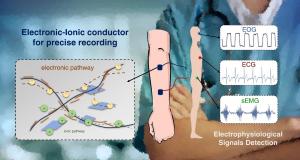Soft Patch Electrodes Introduced for Advanced Human Body Signal Monitoring
GA, UNITED STATES, December 10, 2024 /EINPresswire.com/ -- In a ground-breaking new development, researchers have created conductive films by mixing conductive polymers with two-dimensional carbon materials. These films can be used as electrodes to monitor a wide range of body signals when pasted on the surface of human skin, including cardiac, myoelectric, and ocular signals.
In the human body, signals generated by the movement of charged ions between cells and transmitted at the epidermal interface reflect a wide range of activities. Detecting these signals can help us better understand how body biological systems work. It can also a useful tool for diagnosing a range of diseases, including neurological disorders, heart disease, stroke and cancer.
The caveat in harnessing such signals lies in obtaining good, stable signals from the skin. This means the applied electrodes must have high conductivity and flexible, and can function well in different environments. To address this, a group of researchers from Tianjin University in China have developed a new flexible electrode that can accurately measure electrical signals from the human body.
Yiming Li, the study's lead author and a researcher at the Tianjin Key Laboratory of Molecular Optoelectronic Sciences, explains, “There are a few things that can affect the accuracy of body’s signal measurements. For example, the electrical resistance of the dermis and epidermis weakens the strength of the monitored epidermal signals.”
Additionally, the unavoidable relative motion between the electrodes and skin surface can interfere with data acquisition, and changes in conditions such as skin surface temperature, humidity and sweat secretion can also affect signal quality.
“Hence, if we want wearable tech to accurately and long-term monitor body’s epidermal signals, the materials used in the monitoring electrodes need to have high conductivity, be flexible and stable in the environment,” Li adds.
According to co-corresponding author Yi-Xuan Wang, up until now, the team has been looking at how improving ion transport can help us monitor electrical signals more effectively.
“Our new approach shows that we can get better signals from the human body by reducing the resistance of the film while improving ion transport performance,” says Wang. “We believe this material design strategy for flexible electrodes will help us develop wearable electronic devices.”
DOI
10.1016/j.wees.2024.09.005
Original Source URL
https://doi.org/10.1016/j.wees.2024.09.005
Funding information
Financial support is from the National Key Research and Development Program of China (Grants 2022YFF1202902 and 2023YFB3609001), the National Natural Science Foundation of China (Grants 52273192 and 52121002), and the Haihe Laboratory of Sustainable Chemical Transformations are gratefully acknowledged.
Lucy Wang
BioDesign Research
email us here
Legal Disclaimer:
EIN Presswire provides this news content "as is" without warranty of any kind. We do not accept any responsibility or liability for the accuracy, content, images, videos, licenses, completeness, legality, or reliability of the information contained in this article. If you have any complaints or copyright issues related to this article, kindly contact the author above.

